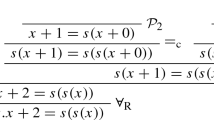Abstract
Linear logic, introduced by J.-Y. Girard, is a refinement of classical logic providing means for controlling the allocation of “resources”. It has aroused considerable interest from both proof theorists and computer scientists. In this paper we investigate methods for automated theorem proving in propositional linear logic. Both the “bottom-up” (tableaux) and “top-down” (resolution) proof strategies are analyzed. Various modifications of sequent rules and efficient search strategies are presented along with the experiments performed with the implemented theorem provers.
Similar content being viewed by others
References
Andreoli, J.-M.: Logic programming with focusing proofs in linear logic,J. Logic Computation 2(3) (1992), 297–347.
Galmiche, D. and Perrier, G.: Automated deduction in additive and multiplicative linear logic, inLFCS'92: Logic at Tver, LNCS 620, Springer-Verlag, Berlin, 1992, pp. 151–162.
Girard, J.-Y.: Linear logic,Theoret. Comput. Sci. 50 (1987), 1–102.
Harland, J. A. and Pym, D. J.: On resolution in fragments of classical linear logic, inLPAR'92, LNCS 624, Springer-Verlag, Berlin, 1992, pp. 30–41.
Hodas, J. and Miller, D.: Logic programming in a fragment of intuitionistic linear logic, inProc. 6th Annual IEEE Symposium on Logic in Computer Science, Amsterdam, July 1991, IEEE Computer Society Press, 1991.
Kleene, S. C.:Introduction to Metamathemaatics, North-Holland, Amsterdam, 1952.
Lincoln, P., Mitchel, J., Scedrov, A., and Shankar, N.: Decision problems for propositional linear logic.Ann. Pure Appl. Logic 56(1–3) (1992), 239–311.
Chirimar, J. and Lipton, J.: Provability in TBLL: A decision procedure, inCSL '91, LNCS 626, Springer-Verlag, Berlin, 1992, pp. 53–67.
Maslov, S. Ju.: An inverse method of establishing deducibility in the classical predicate calculus,Dokl. Akad. Nauk. SSSR 159 (1964), 17–20; Soviet Math. Dokl.5 (1964) 1420, MR 30 #3005.
Maslov, S. Ju.: The inverse method for establishing deducibility for logical calculi,Trudy Mat. Inst. Steklov 98 (1968), 26–87;Proc. Steklov. Inst. Math. 98 (1968), 25–96, MR 40 #5416; 43 #4620.
Maslov, S. Ju.: Proof-search strategies for methods of the resolution type, inMachine Intelligence 6, American Elsevier, 1971, pp. 77–90.
Mints, G.: Gentzen-type Systems and Resolution Rules. Part I. Propositional Logic, inCOLOG-88, LNCS 417, Springer-Verlag, Berlin, 1990, pp. 198–231.
Mints, G.: Resolution calculus for the first order linear logic,J. Logic, Language Informat. 2 (1993), 58–93.
Robinson, J. A.: A machine-oriented logic based on the resolution principle,J. ACM 12 (1965), 23–41.
Author information
Authors and Affiliations
Rights and permissions
About this article
Cite this article
Tammet, T. Proof strategies in linear logic. J Autom Reasoning 12, 273–304 (1994). https://doi.org/10.1007/BF00885763
Received:
Accepted:
Issue Date:
DOI: https://doi.org/10.1007/BF00885763




